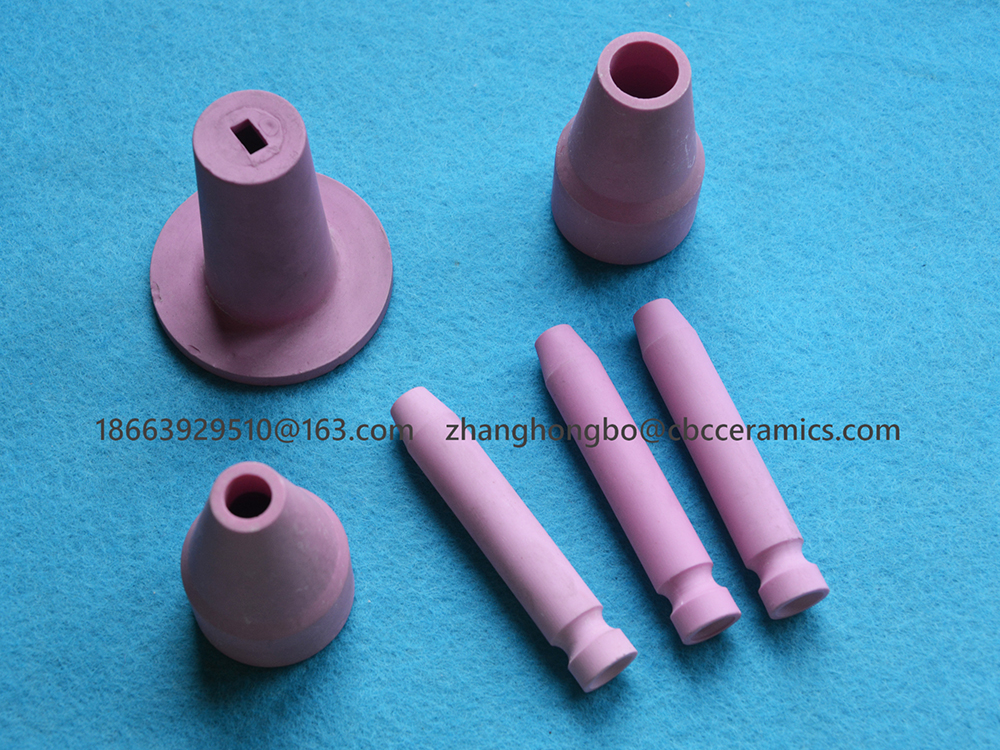
Scrubber Nozzles
Mike,
Can all of the outside surfaces of the nozzle be covered with ceramic? ■
Re: Scrubber Nozzles
Hi Paul,
I don't see why all the outer surfaces of the nozzle can't be protected by ceramic; although, I haven't seen this type of nozzle totally enclosed.
Mike.
Attachments
■
Re: Scrubber Nozzles
Scrubber Nozzles
Hi Paul,
I have attached a drawing and a photo of the application I think you are describing.
The drawing shows a sectional view of a basic high temperature scrubber nozzle fitted with a ceramic insert. The insert is manufactured from a highly thermal shock resistant hard ceramic (3500 Vickers).
Is the wear occurring mainly in the area protected by the ceramic, or do you get a high degree of wear on the outer surfaces as well?
Regards,
Mike Griffiths.
Attachments
■
Scrubber Nozzle Drawing
This is the drawing of the scrubber nozzle, with the ceramic insert coloured in red.
Regards,
Mike.
Attachments
■
Scrubber Nozzles
Ooh, pretty pictures! I like pretty pictures!
Thanks Mike. These are the type of nozzle that we are using and the wear is on the inside bore and on the outside surfaces. Can ceramic be fitted to the outside surfaces of the nozzles and, if it can, will it stay there?
Will the ceramic "really" survive being rapidly cooled by the water? Sometimes the internals of the scrubber get really hot if there is a glitch with the water supply.
How do can the feed tubes to the nozzles be protected?
Paul. ■
Scrubber Nozzles
Paul wrote:
>>Ooh, pretty pictures! I like pretty pictures!
Thanks Mike. These are the type of nozzle that we are using and the wear is on the inside bore and on the outside surfaces. Can ceramic be fitted to the outside surfaces of the nozzles and, if it can, will it stay there?
Will the ceramic "really" survive being rapidly cooled by the water? Sometimes the internals of the scrubber get really hot if there is a glitch with the water supply.
How do can the feed tubes to the nozzles be protected?
Paul.<<
Hi Paul,
Someone once said "A picture is worth a thousand words." I don't know who made such an obvious statement, but he/she must now be famous - I just wish I could remember who it was.
The ceramic used for this application has a thermal conductivity of 200 wm-1k-1, excellent thermal shock resistance and is able to absorb and release heat very quickly. The ceramic has a thermal shock resistance of more than 10 times that of an alumina ceramic.
There are other scrubber nozzle designs, like the one in the attached photo; however, these are not as durable as metal lined units. One-piece ceramic items are easily damaged, but these one piece ceramic nozzles work OK in desulpherisation applications.
I have attached a photo of a ceramic liner used to protect the stainless steel feed tube to the nozzle.
Let me know if you need further info.
Mike.
Attachments
■
Scrubber Nozzles
This board only allows one file download at a time, so here is the photo of the one-piece scrubber nozzle.
Mike.
Attachments
■
Scrubber Nozzles
Hello again Mike,
Can you explain how the cermic tube fits on the nozzle feed tube and how the outside of the nozzle can be protected?
Paul. ■
Scrubber Nozzle
Hi Paul,
The smaller ceramic tube fits over the steel nozzle feed tube and the larger diameter, short, ceramic tube fits over the hexagonal inlet section of the nozzle. The ceramic tubes just rest on the steel nozzle inlet tube and hexagonal inlet section - the bores of the ceramic tubes are a few millimetres larger than the O/D of the inlet steel tube and hexagonal nozzle inlet. The scrubber nozzle is screwed onto the steel inlet tube by hand and a tack weld applied through the hole that can be seen in the side of the longer ceramic tube, just prior to the larger diameter (shorter) ceramic tube, to lock the nozzle in position. Am I making sense here?
I have attached a drawing of the scrubber nozzle with the ceramic protection fitted on the out side surface of the nozzle. The ceramic lined nozzle is tightened into the nozzle body by hand and tack welds applied each side of the nozzle, locking it in position.
To remove the nozzle from the feed tube, the short ceramic tube (on the end of the long ceramic tube) has to be smashed to enable the tack welds to be ground away and the same applies when removing the ceramic lined nozzle section. I hope this all makes sense to you?
Mike.
Attachments
■





Scrubber nozzles
We have wet gas scrubber columns using stainless steel nozzles that suffer badly from high temperature abrasion and corrosion. The temperature in the scrubber ranges from ambient to 1000 Centigrade. We have tried hard welded deposits, but we are still only getting a few weeks life from the nozzles.
Does anyone have any ideas how to extend the working like of these nozzles. We also get severe wear on the 2" feed tubes from the column to the nozzles.
Thanks.
Paul Edwards. ■